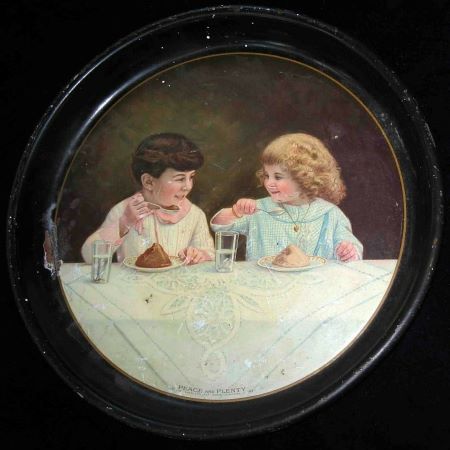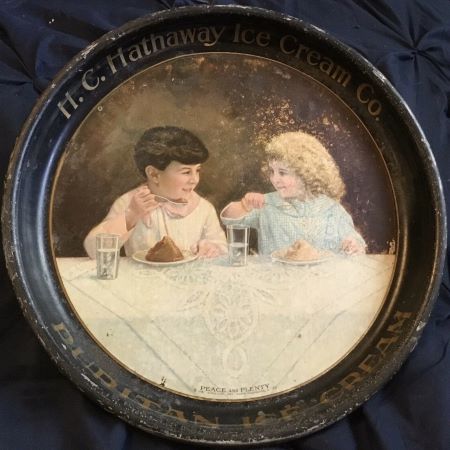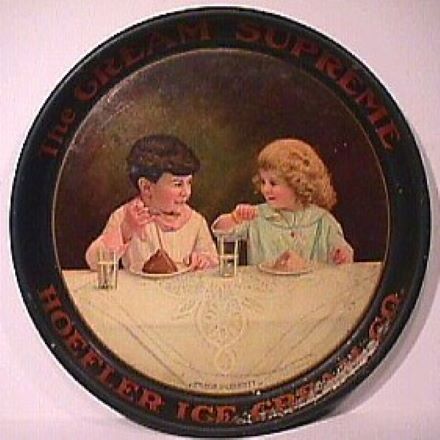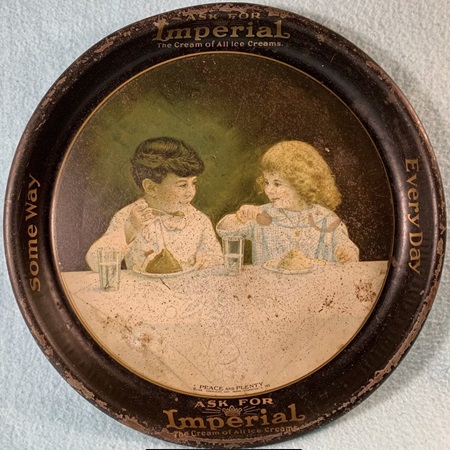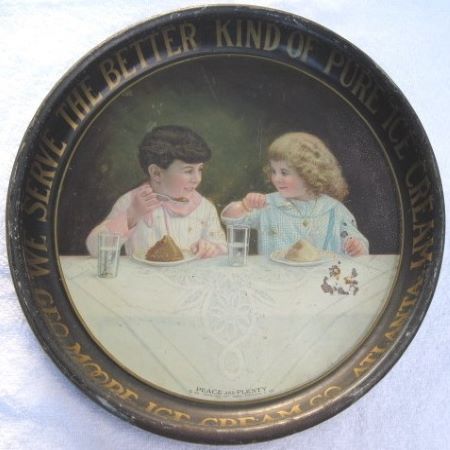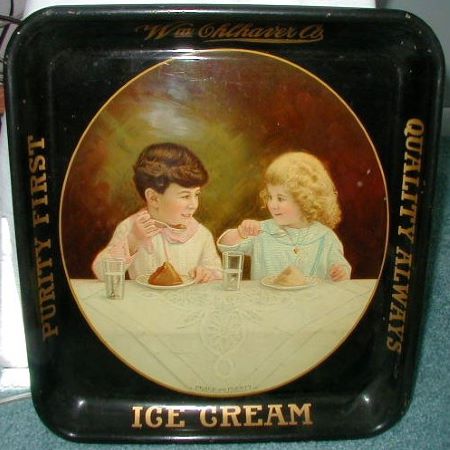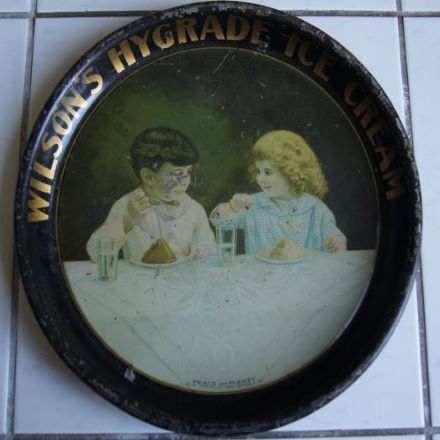The 'Stock' Exchange
American Art Works: No. 143 "Peace & Plenty"
American Art Works: No. 143 "Peace & Plenty"
Date: 1915 to 1920
Size: 13" Rounds &
13" x 13" Squares
Type: Pie
Scarcity: Rare
Value: $$ to $$$
Condition & Brewer Dependent
Size: 13" Rounds &
13" x 13" Squares
Type: Pie
Scarcity: Rare
Value: $$ to $$$
Condition & Brewer Dependent

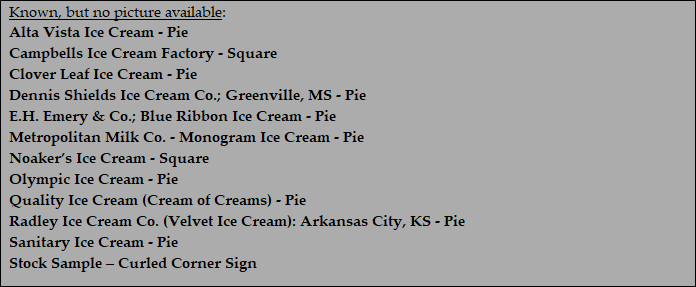
General Comments
No. 143 “Peace and Plenty” marks the fifth design dedicated to an ice cream specific theme. As the prohibition movement gained steam and the number of individual states that enacted prohibition increased (14 by 1915), consumers were looking for a substitute. Into the void left by plummeting alcohol consumption, came ice-cream, marketed partially as a “comfort food” for those committed drinkers bereft of their previous vice (alcohol). The advent of Prohibition was thus a boost to the ice cream business. Americans didn’t simply stop drinking beer, wine and spirits and take up iced confectioneries; over the nine years from 1916 to 1925 ice cream consumption increased 55%, against a population increase of only 15%. Even before Prohibition the ice cream business surge started, due to improvements in technology which boosted ice cream’s popularity. Improved methods led to mass production of ice cream; improved refrigeration preserved the product better
Although fruit sorbets were reportedly the most popular flavors in the 1910s, this design appears to depict the good old standards of chocolate (in front of the boy) and vanilla (in front of the girl). That odd pyramid-like mound found on previous ice cream related designs is still in evidence on their plates despite the Ice cream scoop being widely available.
Other designs have illustrated the evolution of clothing and fashion, particularly for women. By 1915, World War I had already had an impact because cloth was in shorter supply than usual and thus more expensive. As a result, women were moving toward more practical, shorter skirt lengths and fewer undergarments. Tailored clothing gave way to store-bought, off-the-rack garments, changing the silhouette. Children's clothing was affected similarly, with lengths shortening and skirts losing volume to allow more efficient use of cloth.
Boys in 1915 wore mostly short pants paired with white or light-colored, button-down shirts and sometimes jackets matched to the pants. During the period 1900-1930, the fashions of young boys began to change in style, but not color. Pink and blue were used together as "baby colors". Birth announcements and baby books used both colors well into the 1950s, and then gradually became accepted as feminine and masculine colors. Styles and colors formerly considered neutral, including flowers, dainty trim, and the color pink, became more associated with only girls and women. It is clear that pink-blue gender coding was known in the late 1860s, but was not dominant until the 1950s in most parts of the United States and not universal until a generation later.
No. 143 “Peace and Plenty” marks the fifth design dedicated to an ice cream specific theme. As the prohibition movement gained steam and the number of individual states that enacted prohibition increased (14 by 1915), consumers were looking for a substitute. Into the void left by plummeting alcohol consumption, came ice-cream, marketed partially as a “comfort food” for those committed drinkers bereft of their previous vice (alcohol). The advent of Prohibition was thus a boost to the ice cream business. Americans didn’t simply stop drinking beer, wine and spirits and take up iced confectioneries; over the nine years from 1916 to 1925 ice cream consumption increased 55%, against a population increase of only 15%. Even before Prohibition the ice cream business surge started, due to improvements in technology which boosted ice cream’s popularity. Improved methods led to mass production of ice cream; improved refrigeration preserved the product better
Although fruit sorbets were reportedly the most popular flavors in the 1910s, this design appears to depict the good old standards of chocolate (in front of the boy) and vanilla (in front of the girl). That odd pyramid-like mound found on previous ice cream related designs is still in evidence on their plates despite the Ice cream scoop being widely available.
Other designs have illustrated the evolution of clothing and fashion, particularly for women. By 1915, World War I had already had an impact because cloth was in shorter supply than usual and thus more expensive. As a result, women were moving toward more practical, shorter skirt lengths and fewer undergarments. Tailored clothing gave way to store-bought, off-the-rack garments, changing the silhouette. Children's clothing was affected similarly, with lengths shortening and skirts losing volume to allow more efficient use of cloth.
Boys in 1915 wore mostly short pants paired with white or light-colored, button-down shirts and sometimes jackets matched to the pants. During the period 1900-1930, the fashions of young boys began to change in style, but not color. Pink and blue were used together as "baby colors". Birth announcements and baby books used both colors well into the 1950s, and then gradually became accepted as feminine and masculine colors. Styles and colors formerly considered neutral, including flowers, dainty trim, and the color pink, became more associated with only girls and women. It is clear that pink-blue gender coding was known in the late 1860s, but was not dominant until the 1950s in most parts of the United States and not universal until a generation later.
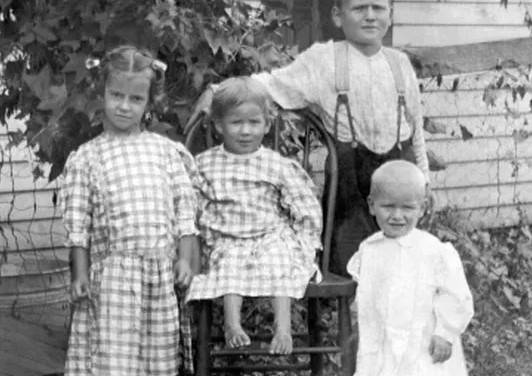
In 1915, girls primarily wore dresses or skirts that ended at about the knee, paired with knee or ankle socks. Girls commonly wore middy blouses -- shirts with a sailor-style collar and loose waist -- and skirts to school. The growing popularity of sailor-style clothing for girls seems to have led to a corresponding drop for similar boys' clothing. Fabrics moved from fragile, easy-soiling muslins of the previous decade to prints and ginghams in bright colors. The boy and girl in this design reflects several of these trends.
Sahling does have an entry in his workbook in December 1914 for “Peace & Plenty stock tray”, although the copyright date that appears on the design is 1915.
Size, Shape and Message Placement
The vast majority of trays are concave pies, although there are a smattering square trays as well. We have also encountered an unmarked curled corner sign version. Rims are black with gold advertising text. We do not recall any with advertising on the face of the tray.
Hager & Price
As mentioned previously, Hager stopped commenting on individual trays after No. 136, but he does include this design in his date of introduction table (1915) and his catalog. Given the subject of the design there are no brewery examples; aside from stock samples they are all ice cream manufacturers. Prices seem to be driven by condition even more so than with brewers. Prices range from single digits to mid-triple figures.
Sahling does have an entry in his workbook in December 1914 for “Peace & Plenty stock tray”, although the copyright date that appears on the design is 1915.
Size, Shape and Message Placement
The vast majority of trays are concave pies, although there are a smattering square trays as well. We have also encountered an unmarked curled corner sign version. Rims are black with gold advertising text. We do not recall any with advertising on the face of the tray.
Hager & Price
As mentioned previously, Hager stopped commenting on individual trays after No. 136, but he does include this design in his date of introduction table (1915) and his catalog. Given the subject of the design there are no brewery examples; aside from stock samples they are all ice cream manufacturers. Prices seem to be driven by condition even more so than with brewers. Prices range from single digits to mid-triple figures.
Confirmed Brewer used Stock Trays
Non-Beer Related & Non-Tray Uses

Click the Picture to Return to Meek & Beach Stock Catalog Page
